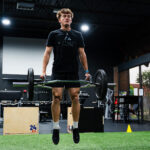Sports Specific Training for Swimmers
Swimming is one of the most physically demanding sports. It requires power, endurance, flexibility, and perfect technique. That’s why dryland sports specific training is essential for peak swimming performance.
You can’t always be in the water, but your training outside the pool can still make you faster. In fact, it’s often the key to unlocking new levels of strength and efficiency.
Why Swimmers Need Sports Specific Training
Water resistance is unique. To excel, swimmers must train their bodies to move with maximum efficiency through that resistance. However, water alone can’t build all the strength and mobility swimmers need.
Land-based sports specific training supports:
-
Stroke power
-
Core and shoulder stability
-
Hip mobility
-
Anaerobic endurance
-
Injury prevention
By combining dryland work with pool sessions, swimmers gain a competitive edge.
Benefits of Training Outside the Pool
1. Better Stroke Efficiency
Core control and shoulder mobility improve body position and streamline mechanics.
2. Increased Propulsion
Leg and upper-body power improve starts, turns, and stroke force.
3. Greater Endurance
Conditioning drills improve your VO2 max and lactic acid tolerance, especially important for longer events.
4. Injury Prevention
Swimmers often face shoulder issues. Specific strengthening reduces overuse risks.
5. Mental Resilience
Challenging dryland circuits build mental toughness that transfers to races.
Weekly Training Outline
| Day | Focus |
|---|---|
| Monday | Core and mobility |
| Tuesday | Upper-body strength + shoulder care |
| Wednesday | Anaerobic dryland circuits |
| Thursday | Leg power and explosive movement |
| Friday | Recovery and light mobility |
| Saturday | Simulated race conditioning |
| Sunday | Rest |
Sample Exercises for Swimmers
Superman Holds
Purpose: Improve core and posterior chain strength
How to do it: Lie face down. Lift arms, chest, and legs off the ground. Hold for 30 seconds. Repeat 3 times.
Plank Row to Press
Purpose: Train the core and shoulder stability
How to do it: In a plank position with dumbbells, row one weight, then press overhead. 3 sets of 10 reps per side.
Jump Squats
Purpose: Develop leg power for starts and turns
How to do it: Squat down and explode up. Land softly and repeat. 3 sets of 8 reps.
Band Face Pulls
Purpose: Strengthen upper back and prevent shoulder injuries
How to do it: Use a resistance band. Pull toward your face, elbows wide. 3 sets of 12.
Flutter Kick Crunches
Purpose: Mimic kick motion and activate the core
How to do it: Lie on your back, legs straight. Alternate quick kicks while holding a crunch. 3 rounds of 30 seconds.
Strokes and Training Specificity
Different strokes have unique physical demands. Tailor dryland training based on your specialty.
-
Freestyle/Backstroke: Prioritize core rotation and shoulder endurance
-
Breaststroke: Focus on hip mobility and inner thigh strength
-
Butterfly: Emphasize explosive upper-body power and spinal mobility
-
IM Swimmers: Need well-rounded strength and flexibility in all planes
That’s the power of sports specific training—customized work for maximum transfer.
Swimming Recovery and Flexibility
Because swimming requires constant, repetitive movement, flexibility and recovery are critical.
Recovery Tips:
-
Stretch shoulders, lats, hips, and ankles daily
-
Foam roll lats, pecs, and hip flexors
-
Include yoga or mobility work twice weekly
-
Use light resistance band warm-ups pre-pool
-
Sleep at least 8 hours and stay hydrated
Want more guidance? The NSCA dryland guide for swimmers offers deeper strategies.
Partner With Experts at Next Level Athletics
Next Level Athletics offers personalized sports specific training for swimmers. Their dryland programs improve stroke performance, injury resilience, and racing mindset.
Whether you’re a sprinter or distance swimmer, youth athlete or collegiate competitor, their tailored approach meets you where you are—and takes you further.
Conclusion: Train for the Podium
Swimming success comes from more than just laps in the pool. It comes from strength, stability, and focused effort outside of it.
Sports specific training makes you stronger, faster, and more durable. When your body is built for speed and endurance, every stroke gets better.
Get out of the pool—and start training smarter today.


Recent Comments